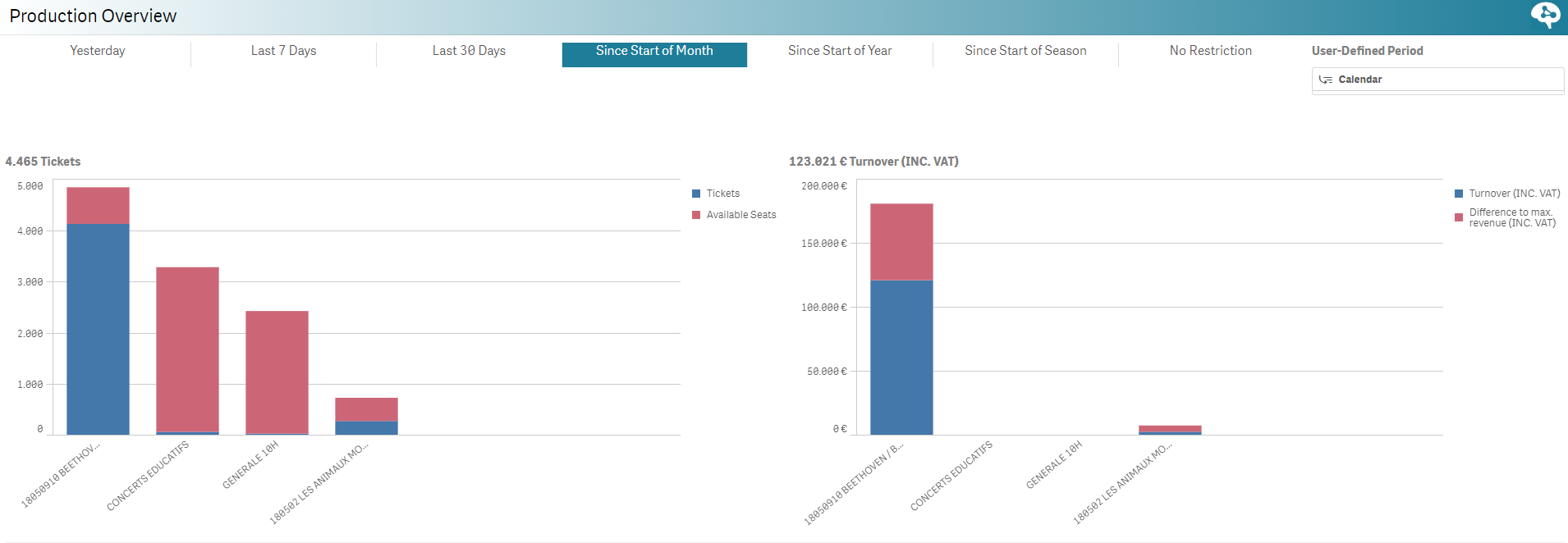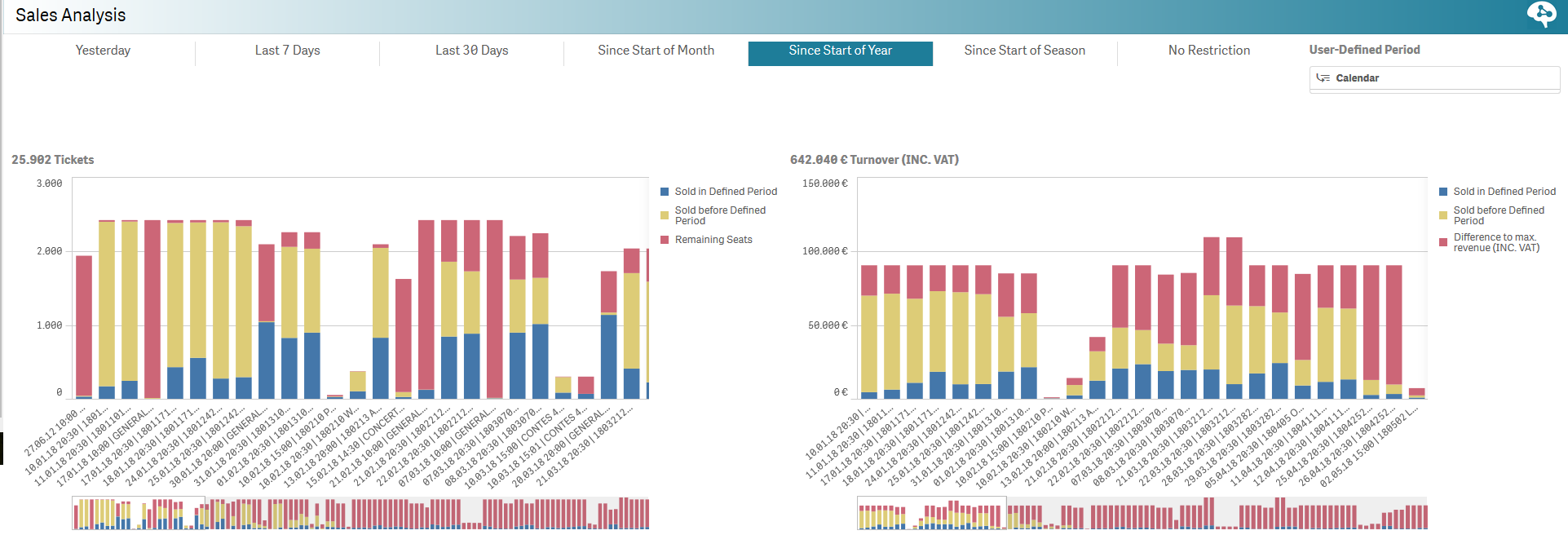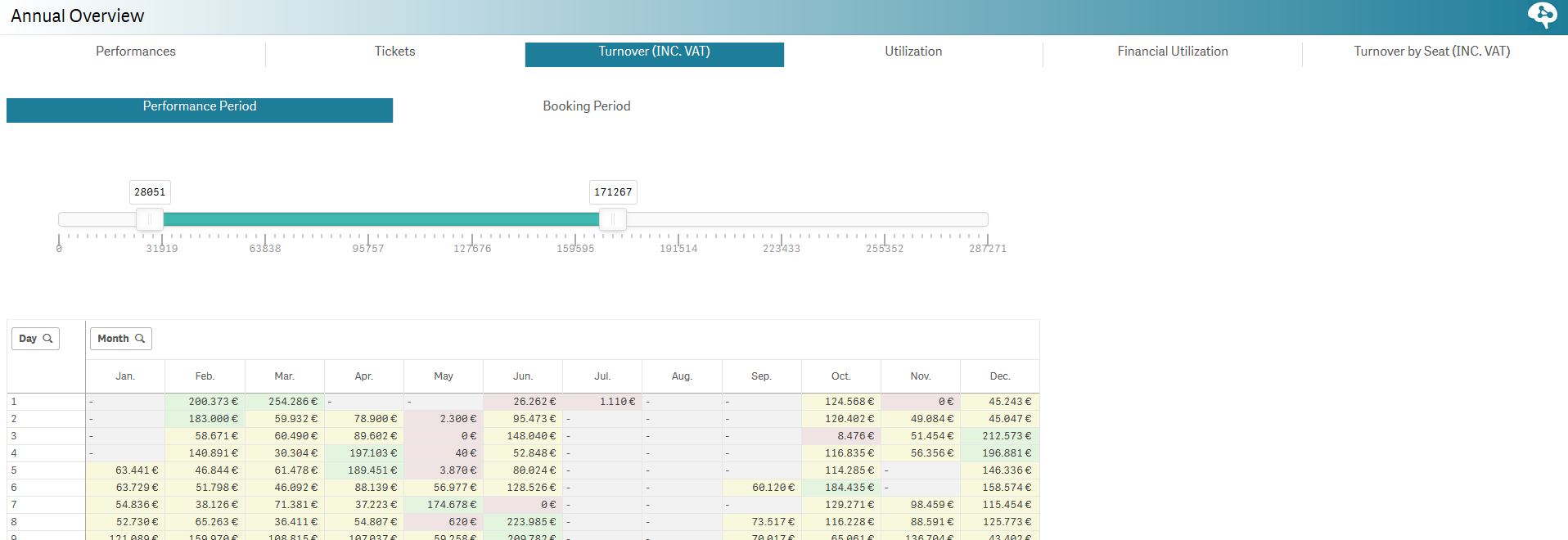...
Liste des principaux indicateurs clés de performance (KPIs) :
| KPI | Définition/calcul |
|---|---|
| Capacité | Le volume total de billets initialement disponibles à la vente. |
| Billets vendus | Total des billets vendus (résas & remboursements exclus). |
| CA par billet | Le chiffre d'affaire moyen. Calculé en prenant le CA global divisé par le nombre de billets vendus. |
| Rabais moyen par billet | Le rabais moyen par billet représente la différence entre le prix de base unitaire par billet et le montact réellement payé. |
| Fréquentation | La fréquentation représente le nombre de billets vendus divisé par la capacité. |
| Différence avec hier | Utile pour comparer des séances d'un même événement. Met en lumière la fréquentation en comparaison avec la veille (ou tout autre période temporelle sélectionnée). |
| CA max. | Il s'agit du chiffre d'affaire maximum si tous les billets disponibles étaient vendus au prix plein (check with ASI). |
| Perfomance CA | Il s'agit du chiffre d'affaire des billets vendus divisé par le CA max. Cela vous montre la performance de votre CA. |
| CA par siège | Vous donne la valeur moyenne d'un siège. Il s'agit du CA des billets vendus divisé par la capacité. |
| Fréquentation moyenne | Nombre de billets vendus + billets réservés divisés par la capacité |
| Cumul annuel à ce jour (YTD |
All tickets that have been given out for free
| ) | La période qui s'étend du début de l'année en cours jusqu'au jour présent, exclu. |
| Année complète | Aucune restriction; affichage de l'année complète. |
| Réduit | Représente la part de billets qui n'ont pas été vendus au prix plein (check with ASI). |
| Gratuités | Tous les billets qui ont été donnés gratuitement. |
| Ventes moyennes en nb de jours avant la séance | Nombre moyen de jours entre la date d'achat et le jour de la séance. |
| Horizon d'achat | Indique le moment où un billet a été acheté en termes de jours avant la séance. Les valeurs possibles sont: Jour de la séance ou après, Semaine passée, Mois passé, 3 mois passés, 6 mois passés ou antérieur. |
| Dernière visite | Date de la dernière visite (de la séance la plus loin dans le temps pour lequel le contact a un billet). |
| Estimation prochaine visite | Si A est la médiane de tous les intervalles en jours entre les visites consécutives d'un client, l'estimation de la prochaine visite est: la date de la dernière visite + A. |
| Interval since last attendance | Number of days between today and the contact's last attendance to a performance |
| Attendance frequency | The median of all intervals between consecutive attendances of a customer (in days). This is an estimation of the average number of days between the contact's visits. |
| Overdue (estimation) | (Interval since last attendance)-(Attendance frequency)*1.5 1.5 is a tolerance factor applied. If the the value is positive, this means the customer has not come for longer than usual (he/she is overdue). If the value is negative, the contact came earlier than expected. |
| Distance to institution | An histogram counting the customers depending on how far they live from the instution (based on the ZIP code) |
| Average price per ticket | An histogram counting the customers depending on how uch they paid in average per ticket. (the total amount of tickets sold divided by the amount of money paid) |
| Purchase: days before the performance | An histogram displaying how many days in average does a customer purchase the tickets before the performance. |
| Customers by production | A count of how many customers have purchased tickets for a givent event |
| Attendance by customer | A count of how many performances a contact has attented. |
List of the reports:
| Standard Dashboards & Reports | Description
| ||||||
|---|---|---|---|---|---|---|---|
| Dashboard | This dashboard gives you a perfect overview of the performances to come. You can select in the upper part the time frame you want to consider and follow your sales, turnover, available seats and other useful KPIs. This dashboard is ideal for a daily follow-up of the sales of you coming performances. | ||||||
| Sales Overview | This report focuses on the latest sales on a time frame selected by the user and enables you to compare with the equivalent past period (today/yesterday, this week/last week, etc). You can know in glimpse if your sales are betterthis month than the month before! The following KPIs are avaiable:
| ||||||
| Performance Report | This report provides an overview of the ticket sales of the past performances during a time frame selected by the user. The chart on the left-hand side shows the number of sold tickets (in blue) compared to the total amount of available seats (in red). The table on the right-hand side will show the actual turnover (in blue) compared to the maximum turnover (see definition in KPI definition). It will enables you to follow-up on your sales per performances and know how they are perfoming. | ||||||
| Production Overview | This report is very similar to the Performance Report, the only difference is that data are grouped by events and not performances. | ||||||
| Production Details - Overview | The Overview is a dashboard showing key values of all events from a defined period (use data selection screen for exemple to select the time frame). You can see the total performances, the coming /past ones, the capacity, number of sold tickets, etc. It will give you a great overview of where you are and where you are heading. The table on the bottom can be grouped by year and months, months and days of the week thus allowing a structured view on the productions. | ||||||
| Production Details - Comparison in weekdays and months | This report will give you some insights on your activity in terms of weekdays and months. Thus, you can quickly see which days of the week have the most performances in average, the highest turnover or amount of sold tickets. You can have the same information in terms of months. See which months/days of the week are the busiest ones! | ||||||
| Production Details - Comparison 2 | This report is worthy to be understood as it enables you to compare events (with single or multiple performance(s)) in terms of ticket available vs. sold per performance and cumulated. It is very usefull to help you determine the balanced number of performances you should plan for a given event for example. Composed of four scatter plots with the following content:
| ||||||
| Sales Report | This report focuses on amount of sales on a daily basis. It will show how many tickets have been sold and if it was for occasionnal contacts, season ticket holders or members. You will also see the turnover split among these audience. The table at the bottom gives you more details on the sales, booking, cancellations and the split by events. | ||||||
| Sales Analysis | This report focuses on the period the tickets were purchased for a given performance. Select "Since Start of the year" and check when did people purchased their tickets? Was it during this periond (in blue) or before (in yellow) and what is the proportion of remaining available seat on sales. The table at the bottom gives you some details on the seat categories, booking, etc. | ||||||
| Annual Overview | In this report, the user is able to select from two dimensions that can be crossed: Dimension 1: Performances, Tickets sold, Turnover, Utilization, Financial utilization and Turnover by Seat. Dimension 2: Performance date or Purchase date. The range slider enables you to change the thresholds to determine the background colors (green, yellow, red) of the table. Here below, we are focusing on the turnover from the point of view of the performances date. We see the turnover by day of the months on annual basis. We can at which time of the month the tunrover is the highest and compare it with other months to determine whether there is a recurent patern or not. | ||||||
| Comparison with previous year | This report is simply a must to follow-up on your sales! You are able to compare sales volumes (tickets sold & turnover) and compare with the same past period. For exemple, below we care comparing two seasons and check the sales months by months and on a cumulative basis as well. Once can see that sales were better in Februrary 2017 than 2018 but were better this January. The table at the bottom will enable you to go deeper in your analysis and sort data by months, productions, sub-themes or venues. | ||||||
| Utilization overview | This report keeps the same logic as the one before but focus on the utilization (amount of sold tickets + reservations) in order to show how full your venue has been in the past months and compare with last year/season. |
...











